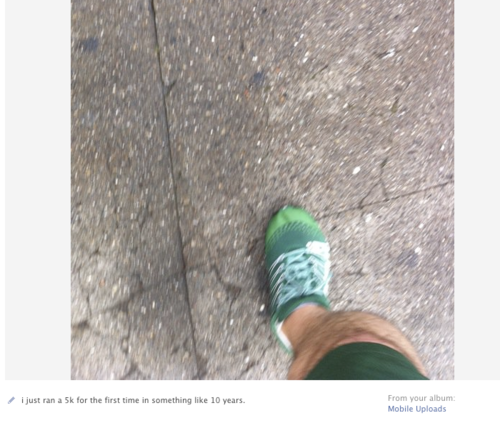 Incremental progress is almost a law of nature; nevertheless, I’ve often fantasized about accomplishing a lofty but distant goal, pursued it for a month or two, merely made incremental progress, and quit.
Incremental progress is almost a law of nature; nevertheless, I’ve often fantasized about accomplishing a lofty but distant goal, pursued it for a month or two, merely made incremental progress, and quit.
Sometime in January, shortly after we first launched iDoneThis, I decided to pursue my long-standing desire to run long distances. I’ve started that many times. Shin splints, knee pains, being in bad shape, busy life, you name it — each time something got in the way and I dropped the habit before accomplishing anything meaningful. Not again.
This time I put a goal in front of myself: run Bay to Breakers — and I carried it through. In 12 weeks, I went from being only able to run 1 mile at a time, to running 7.4 miles continuously (just over running 10K).
The plan was simple: start with a distance that I know I can comfortably run (1 mile in January), sign up to a race that was way longer than I’ve ever run, increase gradually, and track my progress using iDoneThis. The question was whether I’d stick to it.
iDoneThis gives you a checkmark whenever you accomplish your day’s objective, and the desire to get my checkmarks kept me going at first. Every time that I added a checkmark, I kept my streak alive of another week having run a greater distance than the week before.

This was basically the Seinfeld Productivity Secret — once you start a streak, all you have to do is keep the streak alive and that will result in making progress towards your goals. I ran continuously for 1.6 miles last week. Surely I can run 1.7 this week. If I ran 1.7 last week, surely I can do 1.8. Knowing that all I was doing was making small incremental progress kept me from giving up in those last couple of minutes that I was pushing my endurance.

I noticed that as the weeks went on, I began keeping more detailed logs of how far, breaks I took, and how fast I ran. The extrinsic motivation of accruing checkmarks and elongating my streak gave way to an interest in the details and process of running. It turns out that intrinsic motivation is far more powerful and sustainable than extrinsic motivation.

All of a sudden the dedication to keep making incremental progress was not something I actively thought about. It had been downloaded to iDoneThis ala Getting Things Done. GTD’s focus is on recording tasks externally to free the mind of having to remember what needs to be done; rather, you can actually concentrate on the task at hand and getting it done. For me, that process meant offloading from my mind fear of failure and worry about the enormity of the task at hand. I just ran.

12 weeks after only being able to run 1 mile at a time, I ran a continuous 7.4 miles and celebrated by looking goofy with my medal and replenishing many of the calories I burned running.

Gamification can be thought of as bridging the reward gap between incremental progress and eventual goal accomplishment. Motivating myself with checkmarks and streaks was like training a dog with treats — the most amazing part is that even when the treat is removed from the process, the dog will keep performing the trick. For me, running Bay to Breakers was a compelling lesson in how simple mechanics can form consistent habits that can culminate in an experience that’s nearly life-altering.
